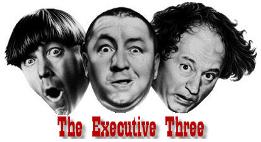Several years ago, Paul Tomblin and his development team were in a constant arms race. Their goal was to defend the MAKE process from falling into the hands of a Certain Developer. Though they were successful most of the time, every once in a while the Certain Developer would manage to get a hold of the MAKE process and wreak havoc that would take a few days, several meetings, and countless apologetic phone calls to undo.
 In an ideal world, a track record of such incompetence and failure would lead to a swift and harsh de-hiring. But in Paul's world, his team was usually in The Wrong and the Certain Developer was always in The Right. After all, the Certain Developer followed the software development methodology pioneered by The Executive Three (President, VP, CTO): if the MAKE process works, then deploy the build to the customer site; if the customer notices any problems, deploy the previous build to their site.
In an ideal world, a track record of such incompetence and failure would lead to a swift and harsh de-hiring. But in Paul's world, his team was usually in The Wrong and the Certain Developer was always in The Right. After all, the Certain Developer followed the software development methodology pioneered by The Executive Three (President, VP, CTO): if the MAKE process works, then deploy the build to the customer site; if the customer notices any problems, deploy the previous build to their site.
In addition to The Executive Three's methodology, Paul's team had to deal with the identity of the Certain Developer: it was none other than the VP himself. That fact alone made protecting the MAKE process an almost impossible task, but they did their best. Unfortunately, no matter what they did -- from security changes to server relocation -- the VP would eventually figure out the MAKE process, ship the software, and start the whole cycle again.
It may not be immediately apparent, but one of the main flaws with The Executive Three's methodology is that it creates many different versions of the software for many different customers. Because the customer may not notice that something broke until several versions later, each version tends to have its own unique set of features and bugs. Guarding the MAKE process was how Paul's team prevented this from happening too often.
Before there was Paul, the development team, the sales team, the marketing team, etc., there was only The Executive Three. They built and sold their first product -- ironically named GOLD -- exclusively using their unique methodology. Though it was retired by the time Paul joined, he had the opportunity to see GOLD when he visited a client site for support.
The customer ran six different versions of GOLD side-by-side. The workstations gave each of these a "friendly" name: Version 3.40.2b was "GOLD (Reports Broken)", Version 3.42.1 was "GOLD (Use Only For Filings)", and so on. In addition, the GOLD server is scheduled to reboot itself four times each day to reclaim leaked memory.
I suppose I'll leave you with one final bit of information that makes this story that much more fun. Not unlike last week's article, Paul's company develops financial software that's used by major stock markets. In his brief tenure, Paul was witness to millions of dollars in loss as a direct result of their software. I think I'll start invested my money in my mattress.

